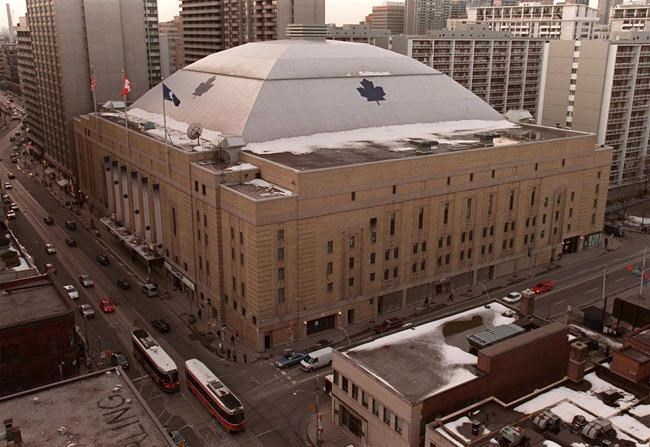
Maple Leaf Gardens in Toronto is shown in a 1999 file photo. Forget floating in the neutral zone, superfluous showboating, and the shinny-style nonchalance so common in recent NHL all-star games. The inaugural 1947 contest in Toronto — the league’s first official all-star game — was an intense, physical affair that featured 12 minor penalties, two fighting majors and a 4-3 scoreline as the NHL all-stars edged the Stanley Cup champion Maple Leafs. THE CANADIAN PRESS/Kevin Frayer
January 30, 2024 - 9:49 AM
TORONTO - Forget floating in the neutral zone, superfluous showboating, and the shinny-style nonchalance so common in recent NHL all-star games.
The inaugural 1947 contest in Toronto — the league's first official all-star game — was an intense, physical affair that featured 12 minor penalties, two fighting majors and a 4-3 score line as the NHL all-stars edged the Stanley Cup champion Maple Leafs.
Now a midseason showcase, the all-star game returns to the Ontario capital this week for a three-day event that includes a skills competition, three-on-three women's game, and fan festival ahead of Saturday's game at Scotiabank Arena.
Things were much different in the debut matchup nearly eight decades ago at Maple Leaf Gardens.
"The players hated each other back then," said hockey historian, author and researcher Paul Patskou. "They never got together. They wanted to win, both the all-stars and the Stanley Cup team. There was bodychecking (and) it was really tough."
Like several unofficial all-star games in the years before it, the 1947 contest was a fundraiser. The newly formed players' pension fund was a beneficiary.
The Maple Leafs hosted the game at the start of the campaign after winning the Cup the previous spring. Top players from the five other Original Six teams provided the opposition.
"You had players playing for the first time together and they were rivals," said Patskou. "Back then, there was a genuine hate on."
Player salaries were modest at the time. Many athletes held regular jobs in the off-season.
Local retailers feted the reigning champions. The Maple Leafs received sweater coats from the Eaton's department store, hats from Simpsons, table lighters from Birks and golf balls from CCM.
The league gifted the Leafs silver tea trays while the city provided engraved gold watches. The all-stars got silver watch chains for their appearance.
Newly installed glass was in place at each end of the Gardens, replacing the old fencing that was used in the past.
"Flat noses are likely to be in vogue this season," Gordon Walker wrote the day after the game in the Oct. 14, 1947 edition of the Toronto Daily Star. "There's no give to the glass like there was to wire screening."
The 17 all-stars wore jerseys with stripes on the arms, an NHL logo in the centre and five white stars across the upper chest. Referee Frank (King) Clancy and his linesmen looked sharp in two-piece midnight blue suits.
More than 14,000 spectators watched Toronto forward Harry Watson open the scoring midway through the first period. He later added a pair of assists as the Maple Leafs jumped out to a 3-1 lead.
Ken Reardon of Montreal and Toronto's Vic Lynn were penalized for fighting in the second period. Chippiness, stickwork and scrums continued throughout the game.
Montreal's Maurice (Rocket) Richard tied it early in the third period and assisted on the game-winner by Chicago's Max Bentley less than a minute later.
"Nice win, gang. That's why you're all-stars," coach Dick Irvin told his team afterward, as quoted in Walker's story.
The style of play was much different in that era. Equipment was smaller, skaters didn't wear helmets, goalies didn't wear masks and there was more room on the ice.
"You played your position and you moved slower," said author and hockey historian Eric Zweig. "Guys were in decent shape to play hockey but they weren't athletes like they are now. Nobody was ripped and nobody could do the things they can do (now)."
On the defensive end, Zweig said players would "patrol the area" in more of a zone setup rather than provide man-to-man coverage. The offensive style was different too, he said.
"Nobody would shoot like Auston Matthews or Alexander Ovechkin in those days, but they also didn't have to," he said. "You could take more time to move in on somebody and make a deke or to wind up for a big, strong slapshot."
Toronto's lineup in the 1947 game included names like Turk Broda, Bill Barilko, Ted Kennedy and Syl Apps. Richard, Boston's Milt Schmidt and Detroit's Ted Lindsay were some of the all-star headliners.
"They didn't have (a) gear except for top gear," said author Andrew Podnieks, who released "The NHL All-Star Game, 50 Years of the Great Tradition" in 2000, the last year Toronto served as host.
"They couldn't take it easy or float and enjoy the night. They played to win."
Walker also quoted NHL president Clarence Campbell in his game story.
"I'll say one thing," Campbell said. "It was a lot rougher than I expected it would be."
This report by The Canadian Press was first published Jan. 30, 2024.
Follow @GregoryStrongCP on X.
News from © The Canadian Press, 2024